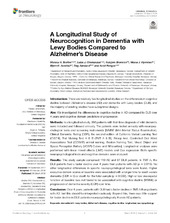| dc.contributor.author | Breitve, Monica Haraldseid | |
| dc.contributor.author | Chwiszczuk, Luiza | |
| dc.contributor.author | Hynninen, Kia Minna | |
| dc.contributor.author | Brønnick, Kolbjørn Selvåg | |
| dc.contributor.author | Auestad, Bjørn Henrik | |
| dc.contributor.author | Aarsland, Dag | |
| dc.contributor.author | Rongve, Arvid | |
| dc.date.accessioned | 2018-07-31T09:38:47Z | |
| dc.date.available | 2018-07-31T09:38:47Z | |
| dc.date.issued | 2018-03-06 | |
| dc.Published | Breitve MH, Chwiszczuk L., Hynninen KM, Brønnick KS, Auestad BH, Aarsland D, Rongve A. A Longitudinal Study of Neurocognition in Dementia with Lewy Bodies Compared to Alzheimer`s Disease. Frontiers in Neurology. 2018;9:124 | eng |
| dc.identifier.issn | 1664-2295 | |
| dc.identifier.uri | https://hdl.handle.net/1956/17912 | |
| dc.description.abstract | Introduction: There are relatively few longitudinal studies on the differences in cognitive decline between Alzheimer’s disease (AD) and dementia with Lewy bodies (DLB), and the majority of existing studies have suboptimal designs. Aim: We investigated the differences in cognitive decline in AD compared to DLB over 4 years and cognitive domain predictors of progression. Methods: In a longitudinal study, 266 patients with first-time diagnosis of mild dementia were included and followed annually. The patients were tested annually with neuropsychological tests and screening instruments [MMSE (Mini-Mental Status Examination), Clinical Dementia Rating (CDR), the second edition of California Verbal Learning Test (CVLT-II), Trail Making Test A & B (TMT A & B), Stroop test, Controlled Oral Word Associations Test (COWAT) animal naming, Boston Naming Test, Visual Object and Space Perception Battery (VOSP) Cubes and Silhouettes]. Longitudinal analyses were performed with linear mixed effects (LME) models and Cox regression. Both specific neuropsychological tests and cognitive domains were analyzed. Results: This study sample comprised 119 AD and 67 DLB patients. In TMT A, the DLB patients had a faster decline over 4 years than patients with AD (p = 0.013). No other longitudinal differences in specific neuropsychological tests were found. Higher executive domain scores at baseline were associated with a longer time to reach severe dementia (CDR = 3) or death for the total sample (p = 0.032). High or low visuospatial function at baseline was not found to be associated with cognitive decline (MMSE) or progression of dementia severity (CDR) over time. Conclusion: Over 4 years, patients with DLB had a faster decline in TMT A than patients with AD, but this should be interpreted cautiously. Beyond this, there was little support for faster decline in DLB patients neuropsychologically than in AD patients. | en_US |
| dc.language.iso | eng | eng |
| dc.publisher | Frontiers | eng |
| dc.rights | Attribution CC BY | eng |
| dc.rights.uri | http://creativecommons.org/licenses/by/4.0 | eng |
| dc.subject | dementia with Lewy bodies | eng |
| dc.subject | Alzheimer’s disease | eng |
| dc.subject | cognitive decline | eng |
| dc.subject | longitudinal | eng |
| dc.subject | neuropsychology | eng |
| dc.title | A Longitudinal Study of Neurocognition in Dementia with Lewy Bodies Compared to Alzheimer`s Disease | eng |
| dc.type | Peer reviewed | |
| dc.type | Journal article | |
| dc.date.updated | 2018-04-10T13:24:37Z | |
| dc.description.version | publishedVersion | |
| dc.rights.holder | Copyright 2018 The Author(s) | eng |
| dc.identifier.doi | https://doi.org/10.3389/fneur.2018.00124 | |
| dc.identifier.cristin | 1534262 | |
| dc.source.journal | Frontiers in Neurology | |

